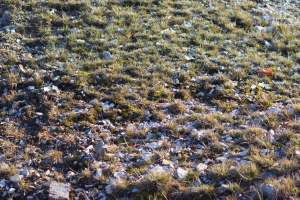by Alana Coulombe, Education programs administrator
Why do some plants along roadways have brown or scorched leaves or needles in the spring? Although road salts are widely used to combat icy conditions during the winter, the environmental consequences are often not obvious until the spring. Road salt sprays can harm nearby vegetation by penetrating leaf scars and killing dormant buds, and by accumulating in the soil where they are taken up following the same route as other nutrients in plants.
Salt accumulation is a significant abiotic (non-living) environmental stress that limits plant growth and productivity across the world. Evidence suggests that more than 20% of the world’s cultivable lands are affected by salt stress, and this number is growing with both natural and anthropogenic influences (Hasanuzzaman & Fujita, 2022).
Soil salinity is defined as the accumulation of soluble salts in soil. Some accumulation can be caused by natural processes including the weathering of rocks, saltwater intrusion from nearby coastal areas, and evaporation in dry climates with low precipitation rates (Cherlinka, 2021). Human activities such as native vegetation removal, improper drainage, synthetic fertilizer application, excessive irrigation, and the use of road salts are major contributors to soil salinity and the creation of salt vulnerable areas (Cherlinka, 2021).
For example, improper drainage combined with the removal of native vegetation that normally filters and channels excess water through its roots results in excess water accumulation on the surface. As groundwater levels rise, so do the salts deep in the soil. This leads to a build-up of salt in the topsoil. Additionally, the use of road salts can affect plants through aerial drifting from vehicles and leaching into root zones. Salinized soils present unique challenges in different landscapes and have profound ecological impacts, with detrimental effects on plant growth, agricultural productivity, and freshwater ecosystems.

In plants, salt stress increases the intracellular osmotic pressure and can cause sodium ions to accumulate to toxic levels (Hasanuzzaman & Fujita, 2022). Soil salinity can inhibit plant growth and reproduction by reducing the water absorption capacity of root systems (Hanin et al., 2016). High levels of salinity can thus disrupt a plant’s osmotic activity by preventing the uptake of water and nutrients (Hanin et al., 2016). This can lead to nutritional and hormonal imbalances as well as water-deficit stress such that the plant behaves in a physiological drought-like state (Hasanuzzaman & Fujita, 2022).
Subsequent oxidative stress can cause injury and increase a plant’s susceptibility to disease and other environmental stresses such as wind and drought (Hasanuzzaman & Fujita, 2022). Additionally, salt accumulation can harm young photosynthetic leaves and accelerate their senescence (aging process) and water loss (Hanin et al., 2016). As sodium ions accumulate in plant cells, they cause an ionic imbalance resulting in the toxicity of transpiring leaves (Hanin et al., 2016). Salt sprays can also burn leaves, buds, and small twigs, causing exposure of their developing tissues.
Native plants vary in their ability to tolerate salt-affected soils. Salt tolerance describes the relative growth of plants, without significant adverse effects, in the presence of salinity in water on its leaves or in the soil around its roots. This ability is determined by several biochemical pathways involved in the retention and acquisition of water, protection of photosynthetic functions, and maintenance of ion homeostasis (Parida & Das, 2005).
Plant adaptations to salinity stress involve complex physiological traits, metabolic pathways, and molecular and cellular gene networks (Gupta & Huang, 2014). Critical responses for salinity tolerance involve changes in osmotic regulation, stress signalling, hormone and antioxidant metabolism, and mechanisms controlling ion uptake, transport, and balance (Gupta & Huang, 2014). Interestingly, some studies suggest that plants possess a sensory network that can rapidly transmit information between distant sites and signal downstream protein activity and gene transcription to regulate their salt stress response (Hanin et al., 2016).
There are only a few plant species, known as halophytes, that are truly salt-loving and fully adapted to grow in saline conditions. Excluders, a type of halophyte, prevent salt entry at the plant root and can be used to stabilize salt-affected soils (Partners in Project Green, 2024). Other halophytic species present a potential method for remediating areas of land heavily impacted by salt to restore saline soils (Partners in Project Green, 2024). These halophytes can thus be utilized for phytoremediation efforts where plants are used to clean up contaminated environments.

Switchgrass (Panicum virgatum) is a halophytic grass species native to Ontario.
Partners in Project Green (2024) have identified at least four halophytic grass species native to Ontario with this potential ability. Switchgrass (Panicum virgatum) and Sand Dropseed (Sporobolus cryptandrus) are accumulator halophytes that can take up salt from the soil through their roots to store in their stems and leaves (Partners in Project Green, 2024). Alternatively, some halophytes can disperse excess salts taken up from the soil into the air by crystallizing and excreting salt droplets through specialized salt glands on their leaf surfaces (Partners in Project Green, 2024).
What Can You Do?
You can help limit salt accumulation in the environment by avoiding the use of synthetic fertilizers, adopting water management best practices to improve drainage and irrigation efficiency, planting deep-rooted native vegetation, utilizing road salt alternatives, and minimizing road salt applications during the winter.
Do not let salt-affected soils stop you from planting native vegetation to reduce erosion, mitigate flood impacts, protect freshwater habitat, and promote climate change resilience! Several native plant species have developed mechanisms to cope with salt stress by either limiting salt entry by the roots, or by controlling its concentration and distribution (Hanin et al., 2016). Shrubs like Staghorn Sumac (Rhus typhina) and trees like Red Oak (Quercus rubra), along with other salt tolerant species, can be utilized along roadsides that receive runoff and sprays containing road salt. For a list of salt tolerant species native to Eastern Ontario, check out Watersheds Canada’s new resource – Salt Tolerant Native Plant List for Eastern Ontario. Be sure to also visit The Natural Edge’s free, Canada-wide Native Plant Database to discover which vegetation is naturally suited to withstand the climate, soil types, and environmental conditions of your local area!
Protecting our freshwater sources is important, and it is our collective responsibility to harmonize our actions accordingly. You can do your part by sharing the resources and information from Watersheds Canada’s road salt awareness campaign!
References
Cherlinka, V. (2021). Soil salinization causes & how to prevent and manage it. EOS Data Analytics. https://eos.com/blog/soil-salinization/
Gupta, B., & Huang, B. (2014). Mechanism of salinity tolerance in plants: Physiological, biochemical, and molecular characterization. International Journal of Genomics, 2014, 701596. https://doi.org/10.1155/2014/701596
Hanin, M., Ebel, C., Ngom, M., Laplaze, L., & Masmoudi, K. (2016). New insights on plant salt tolerance mechanisms and their potential use for breeding. Frontiers in Plant Science, 7, 1787. https://doi.org/10.3389/fpls.2016.01787
Hasanuzzaman, M., & Fujita, M. (2022). Plant responses and tolerance to salt stress: Physiological and molecular interventions. International Journal of Molecular Sciences, 23(9), 4810. https://doi.org/10.3390/ijms23094810
Parida, A. K., & Das, A. B. (2005). Salt tolerance and salinity effects on plants: A review. Ecotoxicology and Environmental Safety, 60(3), 324–349. https://doi.org/10.1016/j.ecoenv.2004.06.010
Partners in Project Green. (2024). What are halophytes? Toronto and Region Conservation Authority. https://partnersinprojectgreen.com/what-are-halophytes/
This piece is part of an education toolkit generously funded by:


